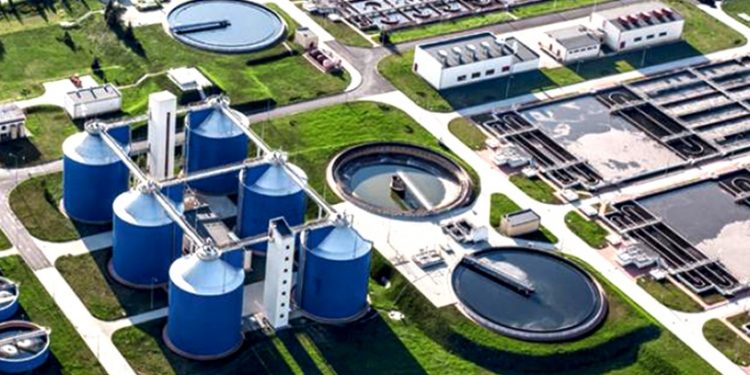Page Contents
What Is A Sewage Treatment Plant?
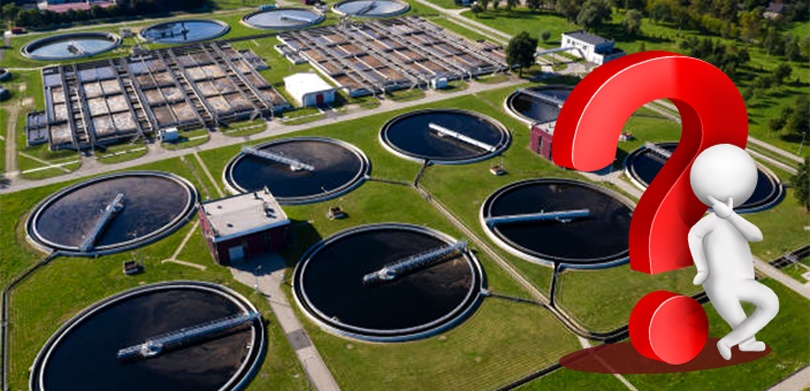
The sewage treatment Process (STP) is the collection of waste domestic water, treating them, and then disposing of them. This process includes treating the water and then disposing of it in the environment or reusing the water. Sewage treatment plant in residential building include low-cost installation and maintenance.
If the water coming out of domestic use is not treated properly, it will contaminate and impact the environment negatively. The solid and liquid waste created by humans and industry disposal damages the water bodies to the maximum.
Human waste is highly prone to catching bacteria. Hence, if the water is not treated properly then, it will contaminate the water bodies and become a health hazard for you. So, it is vital to install sewage treatment plant in residential building.
STP Plant Process
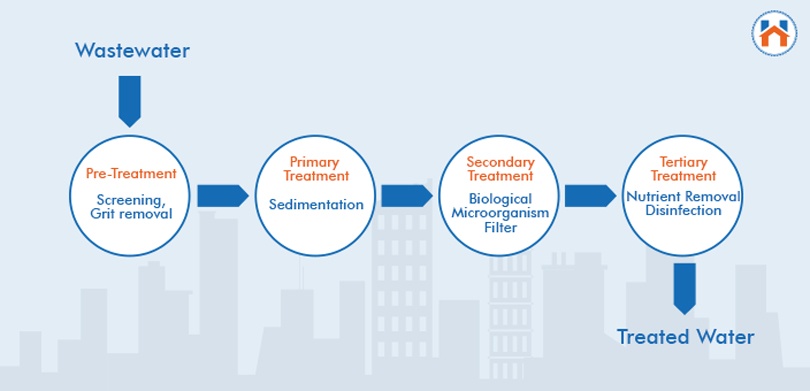
To treat the wastewater from the domestic, there are 4 steps in the STP plant process which are explained in the following:
- Pre-treatment: In this step, the materials which can be easily collected are removed from the water so that they do not clog or damage the pumps. For residential buildings, manually cleaned screens are used for this purpose.
- Primary treatment: Here, the sewage water is held temporarily in a large basin so that heavy solids can settle down and lighter solids or oil and grease can float on the surface. The wastes from the bottom and top are removed and transferred to the secondary treatment stage.
- Secondary treatment: Water-borne microorganisms perform this stage of treatment in a managed habitat. In this stage, the microorganisms remove the dissolved biological matter from the water. However, a separate process is done to remove the microorganisms before stepping to the next stage of tertiary treatment.
- Tertiary treatment: In this stage, the water is disinfected chemically or physically before discharging it into the water body. It is also used to irrigate golf courses. If the water is cleaned sufficiently, then it can also be used for agricultural purposes and groundwater recharge.
Sewage Treatment Plant Design For Apartments
The STP plant to treat wastewater can be easy to install due to its simple processes. You might require a few materials to build the STP plant. You can follow the steps and the reference image.
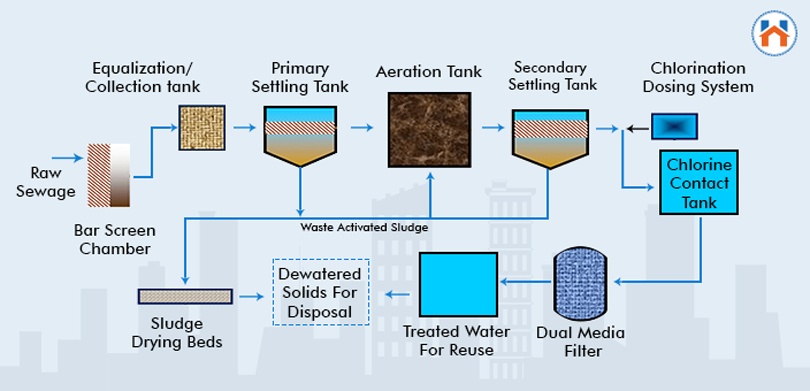
- Pre-treatment stage: The initial stage as discussed is to collect all the large objects through screening so that it does not clog chambers or pipes. You can create a big chamber to store the water and use large screens to collect big wastes like wet wipes, diapers, plastic objects, and others. The inlet chamber will include different types of screens inside to collect as many large objects or wastes as possible.
- Primary treatment stage: The next step is to separate solid organic wastes like human waste. These get deposited at the bottom and form sludge. The sludge is collected in another tank which is used to dry out the sludge to use at an appropriate place.
- Secondary treatment stage: In this stage, the air is pumped to produce bacteria which is known as the activated sludge method. A filter bed is to be made containing bacteria that will break waste into the harmless matter.
- Tertiary treatment stage: The last dirt from the water should be removed. This stage depends on the sensitivity and type of the water. Phosphorus and nitrate should be removed before it is discharged into the water body.
STP In Apartments
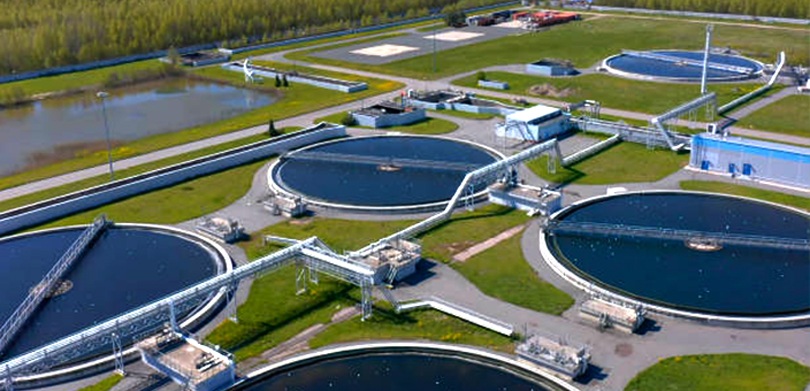
You need to ensure that the water discharged from your apartment is not contaminated and should not affect the water bodies. If the water bodies become polluted, then they will grow microscopic organisms which will cause many health issues.
If the sewage water coming out from apartments is not treated properly, then it will have a negative impact on human health and the environment.
STP plants in apartments will help in eliminating this condition. When you step forward toward environmental preservation, you create a better future for your children.
Sewage Treatment Plant For Apartments
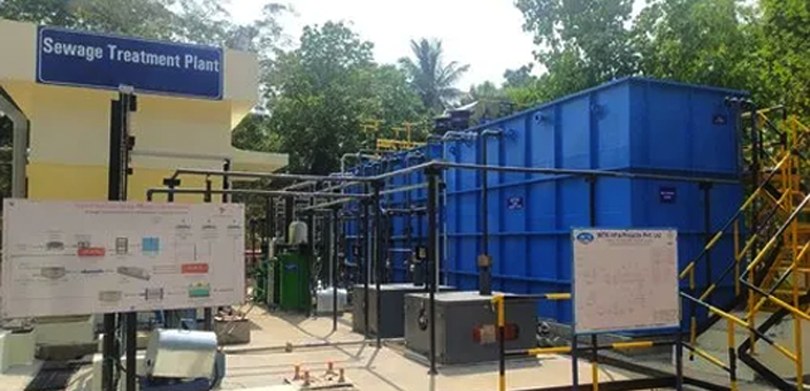
As per the environmental laws, STP plants are mandatory for every apartment to install. It is very useful for the environment to install STP plants in apartments. The reasons why it should be installed:
- The STP plants are simple and affordable plants are affordable and simple to install.
- STP plants help in treating the wastewater and then release it into the groundwater.
- The water treated from the STP plant can be used for washing, toileting, watering plants and etc.
- When you are treating the water properly before discharging it to the groundwater, you are reducing the impact and enhancing environmental health.
FAQs
| Q1: How much does it cost to build an STP plant for apartments?
Ans: For treating water disposed of apartments, STP plant of Rs 2.5 – 3 lakhs. The installation cost of the STP plant for apartments will be less. However, it requires constant maintenance to operate properly. |
| Q2: How many types of STP are there?
Ans: There are 4 types of Sewage Treatment Plants which are Activated Sludge Plant (ASP), Rotating Disc System (RDS), Submerged Aerated Filter System, and Sequencing Batch Reactors. |
| Q3: Which are the processes included in STP?
Ans: There are 4 processes that are included in the STP like Pre-treatment, Primary treatment, Secondary treatment, and Tertiary treatment. |
| Q4: Which components are required for building an STP plant in an apartment?
Ans: Major components which are required for building an STP plant in an apartment are screen bars, grit chamber, biological filter, aeration tank and etc. |

